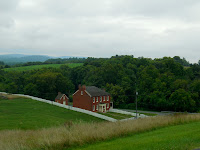 History Alert: Though they were on the same battlefield, the Union Army called it the Battle of Antietam (a nearby creek), it was referred to as the Battle of Sharpsburg by the Confederates. I imagine this can be confusing on history tests, but you won't have to worry about that.
History Alert: Though they were on the same battlefield, the Union Army called it the Battle of Antietam (a nearby creek), it was referred to as the Battle of Sharpsburg by the Confederates. I imagine this can be confusing on history tests, but you won't have to worry about that. This battle was an accident. Lee was on the offensive into northern territory, but had to split his army into four sections. A copy of his orders to one of his generals was lost--then found by a Union soldier--wrapped around 3 cigars. After smoking the cigars, the word got passed to the officers. When Gen. McClellan read them, he knew he had the Confederate battle plan in his hand and he could strike while the Rebels were divided.
I don't know if I've mentioned this before, but there are markers like these at all the battlefields. They explain in detail what actually happened at a particular site. Sometimes give a , and a complete description of who did what, when, where and why. Plus NPS puts up informational signs all over the place too.
The battle only lasted 12 hours that day in September of 1862, but Antietam/Sharpsburg (pick your preference; pick your side) became the bloodiest one-day battle of the Civil War. I always see the casualty numbers posted all over and think they're obscene and disheartening for both sides.
Alexander Garden took photographs several days after the battle. This one of Dunker Church is one of the most famous of the war. When they were exhibited at Matthew Brady's (I've heard of him! He took pictures of Lincoln.) gallery in NYC, they shocked the public because they didn't match the romantic paintings they'd seen of battles. It made people think a different way about the war. We get the same thing now from war correspondents in the Middle East.
We wandered around the Poffenberger farm near the North Woods where General Hooker's men spent the night before the battle. Apparently they did a lot of damage to many of the farms around here with little recompense from the government. (Surprise, surprise.) Ordinary people were pretty ticked off.
Lots of places here look innocuous now. These cornfields and fields, woods and farms were all scenes of terrible fighting. They're trying to make the battlefield look a lot like it did then. They're planting trees where woods that played a critical part stood. They've leased out the fields to be farmed (although I'm pretty sure soybeans weren't planted in Maryland in 1862.) Then you see a sign like the one below that shows details of the engagement. (And, yes, it's a fly on the sign. I can't go back and shoo it away now.)



This farm road served as a breastworks (temporary fortification) for the Confederates. It was a good position for awhile but then they were stuck and couldn't get away in any direction. Afterward the dead lay in rows. Photos at the Visitor Center are pretty graphic.
At Lower Bridge across Antietam Creek, five hundred Confederates held off Federal troops for over three hours. Bodies were piled on top of each other. Picturesque isn't picturesque in war. They've renamed the bridge Burnside Bridge. (Monuments and bridges are named after the victors.)
Basically a draw, when the Armies left the area, the dead and wounded were left behind for civilians to care for. Think that didn't mess up people's lives? At first they buried the bodies where they fell. Later Union soldiers were reburied here at Antietam National Cemetery. The Confederates were buried in other towns.
Things that came out of this battle that changed the world:
- Emancipation Proclamation
- Clara Barton (A symbol of the Red Cross was made from a brick from the home where she was born and placed at the base of the monument--isn't that cool?)
- Ambulance corps
- Triage

.JPG)

.jpg)
.JPG)

.JPG)

.JPG)
Post a comment.
Post a Comment
Please leave comments here: